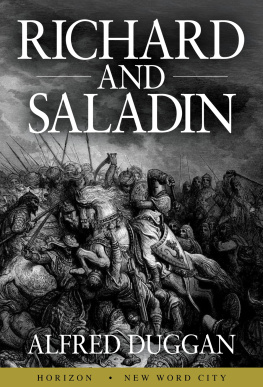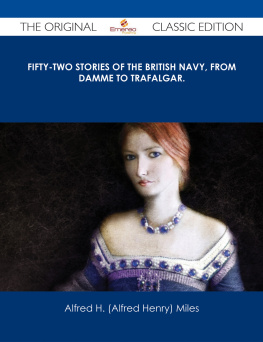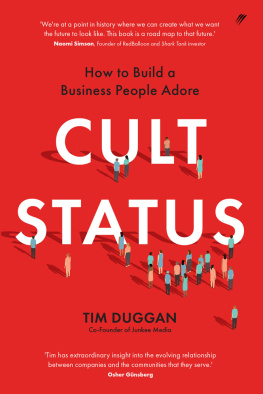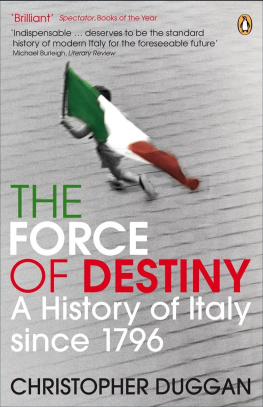Alfred Duggan - The Byzantines
Here you can read online Alfred Duggan - The Byzantines full text of the book (entire story) in english for free. Download pdf and epub, get meaning, cover and reviews about this ebook. year: 2016, publisher: New Word City, Inc., genre: Religion. Description of the work, (preface) as well as reviews are available. Best literature library LitArk.com created for fans of good reading and offers a wide selection of genres:
Romance novel
Science fiction
Adventure
Detective
Science
History
Home and family
Prose
Art
Politics
Computer
Non-fiction
Religion
Business
Children
Humor
Choose a favorite category and find really read worthwhile books. Enjoy immersion in the world of imagination, feel the emotions of the characters or learn something new for yourself, make an fascinating discovery.
- Book:The Byzantines
- Author:
- Publisher:New Word City, Inc.
- Genre:
- Year:2016
- Rating:3 / 5
- Favourites:Add to favourites
- Your mark:
- 60
- 1
- 2
- 3
- 4
- 5
The Byzantines: summary, description and annotation
We offer to read an annotation, description, summary or preface (depends on what the author of the book "The Byzantines" wrote himself). If you haven't found the necessary information about the book — write in the comments, we will try to find it.
The achievement of the Byzantines (who called themselves Romans) was to keep barbarians at bay, create a new art, preserve Western culture for 1,000 years, and push a little further the limits of both piety and depravity. Here, in this essay from respected British historian Alfred Duggan, is their story.
Alfred Duggan: author's other books
Who wrote The Byzantines? Find out the surname, the name of the author of the book and a list of all author's works by series.
The Byzantines — read online for free the complete book (whole text) full work
Below is the text of the book, divided by pages. System saving the place of the last page read, allows you to conveniently read the book "The Byzantines" online for free, without having to search again every time where you left off. Put a bookmark, and you can go to the page where you finished reading at any time.
Font size:
Interval:
Bookmark:
It is only recently that the word Byzantium has been freed from the contempt attached to it by generations of uncomprehending, humanist-minded historians. Preeminent among them was Edward Gibbon, for whom Byzantine history was a tedious and uniform tale of weakness and misery in which not a single discovery was made to exalt the dignity or promote the happiness of mankind. Christian Byzantium - or rather the triumph of Christianity itself - marked for Gibbon the end of the classical civilization he so much admired, marked indeed the decline and fall of the Roman Empire. At the end of his vast work, The History of the Decline and Fall of the Roman Empire, published between 1776 and 1788, he notes: I have described the triumph of barbarism and religion.
Some 100 years later, historian William Lecky was still echoing Gibbons dismissive view: Of that Byzantine Empire, the universal verdict of history is that it constitutes, without a single exception, the most thoroughly base and despicable form that civilization has yet assumed... [It] is a monotonous story of the intrigues of priests, eunuchs, and women, of poisonings, of conspiracies, of uniform ingratitude, of perpetual fratricides.
Judgments like this are not likely to be made today. Byzantine history and civilization have become legitimate objects of academic attention. Byzantine society is no longer regarded as the stagnant playground of decadent voluptuaries, immersed in sensuality and bestirring themselves only when provoked by some outburst of public spleen in the Hippodrome, or by some hair-splitting theological subtlety thrown into their midst by fanatic monks. In art, literature, statesmanship, diplomacy, and war, Byzantiums achievements are now recognized, even admired. The philosopher Alfred North Whitehead went so far as to assert that its culture was superior to that of classical Rome. Some historians have claimed that it afforded greater opportunities for living a civilized life than the Pax Augusta. It might in fact seem that the wheel has come full circle, and that Gibbons thesis is being reversed: it is no longer a question of Romes decline and fall, but of Byzantiums ascent and triumph.
The Byzantine Empire was not simply the Roman Empire extended through another thousand-odd years of slow ossification and decay.
This was a new creation, growing out of the Roman past but essentially different from it. Indeed, it was precisely a failure of ideology in the Empire of the Caesars that made a new form of society imperative if Western civilization was to survive. Already in the second century A.D. the Roman Empire was threatened with disruption. There were civil wars within and frontier wars without; legions mutinied, Goths and Parthians bestirred themselves. The highly centralized administrative machinery creaked under the strain. Disaster was averted for the time being by Diocletian, who came to power in A.D. 284. He introduced a series of measures to decentralize and stabilize the Empire, now split for this purpose into four great compartments. But these reforms only postponed matters. After his death, struggles broke out between the rulers of the various parts of the Empire as they contended for the imperial throne. And it was only in A.D. 323 that the triumphant survivor was able to take the steps that created the empire of the Byzantines.
This survivor was Constantine the Great. He was born in 272 A.D. in Moesia, in present-day Serbia, and as a youth was sent to the court of Nicomedia in Asia Minor, which Diocletian had already chosen for his headquarters in preference to Rome. After serving in Persia and Egypt, he was acclaimed Caesar at York, in England, where his father, a political and military advisor and Senior Western Emperor, had died while on an expedition against the Scots. The next six years Constantine spent in Gaul and Italy as co-emperor with Maxentius, and in A.D. 312 he captured Rome from his colleague. This made him sole emperor in the West, with Licinius, sole emperor in the East, as his only rival. His final triumph did not come until A.D. 323 with the defeat and capture of Licinius.
Faced now with the task of arresting the disintegration of the Empire and of welding its heterogeneous elements, both territorial and cultural, into a new coherence, Constantine made it his first concern to choose and construct a new imperial capital. Where should this be? Rome was the scene of conspiracy and intrigue, while to the north and west were lands of barbarity. The East seemed the obvious choice: there was the main focus of trade; there was a need to fashion resistance against the Parthians and to check the westerly migrations from the steppes; and it was there that Christianity was rapidly gaining followers. And if the East was obvious, what better site could there be than the small town of Byzantium? Set on a triangular peninsula commanding the mouth of the Bosporus, which links the Sea of Marmara with the Black Sea and divides Europe from Asia, Byzantium seemed to meet all the requirements. The climate was cool and healthy. Along one side of the triangular peninsula was an inlet known as the Golden Horn that formed a perfect natural harbor. To the south lay the Aegean and the rich gardens of Asia Minor, source of all the earths fruits, and beyond, the flax fields of Egypt. To the east, as far as India and China, stretched the trade routes along which passed spices and ivory and porcelain and other riches, the raw materials of Byzantine cuisine and art. To the north lay Russia and the Black Sea ports through which flowed wheat and furs, honey and gold, wax and slaves. Byzantium was easily defended, as Constantine had discovered during the war with Licinius, and he must have sensed possibilities as he chose this site and marked out its boundaries. For more than a thousand years, it was to be the focus of Western civilization.
Edifice after imperial edifice began to rise on the spacious platform, once the ancient acropolis, of the peninsula that divided the Sea of Marmara from the still waters of the Golden Horn. To the east of this platform was the Senate House; to the south was the Great Palace, a dense group of buildings stretching through gardens down to the shore; to the west lay the Forum and the vast theatre of the Hippodrome, capable of seating 40,000 people and containing works of art Constantine had rifled from the entire classical world. Northeast of the Hippodrome, on the headland most visible to ships approaching from the south, Constantine placed the Church of the Holy Wisdom, Hagia Sophia. Enlarged by his son Constantius and rebuilt in the sixth century by the emperor Justinian, it was eventually to be recognized as the crowning glory of the Empire.
Constantine also set up a huge column rising from a white marble plinth and supporting a Greek Apollo whose head was replaced by that of the Emperor encircled with the golden rays of the sun. Within the plinth were enshrined such purported relics of special veneration as a casket holding crumbs from the bread with which Christ fed the 5,000, the adze with which Noah built the ark, the alabaster box of ointment with which Mary anointed Jesus, and the crosses of the two thieves crucified with Jesus of Nazareth which the Emperors mother, Saint Helena of York, had recently brought from Jerusalem. The inscription on the plinth of Constantines column read: 0 Christ, Ruler and Master of the World, to Thee have I now consecrated this obedient City. In May of 330 A.D., the city was solemnly dedicated and the Byzantine Empire inaugurated.
For this empire, Constantine the Great laid both the temporal and spiritual foundations, and in it he fused together the political legacy of Rome, the cultural legacy of the Hellenic world, and the explosive dynamism of the Christian faith. It was to last for 1,123 years, and to be governed by no less than eighty-eight rulers in succession.
Next pageFont size:
Interval:
Bookmark:
Similar books «The Byzantines»
Look at similar books to The Byzantines. We have selected literature similar in name and meaning in the hope of providing readers with more options to find new, interesting, not yet read works.
Discussion, reviews of the book The Byzantines and just readers' own opinions. Leave your comments, write what you think about the work, its meaning or the main characters. Specify what exactly you liked and what you didn't like, and why you think so.










